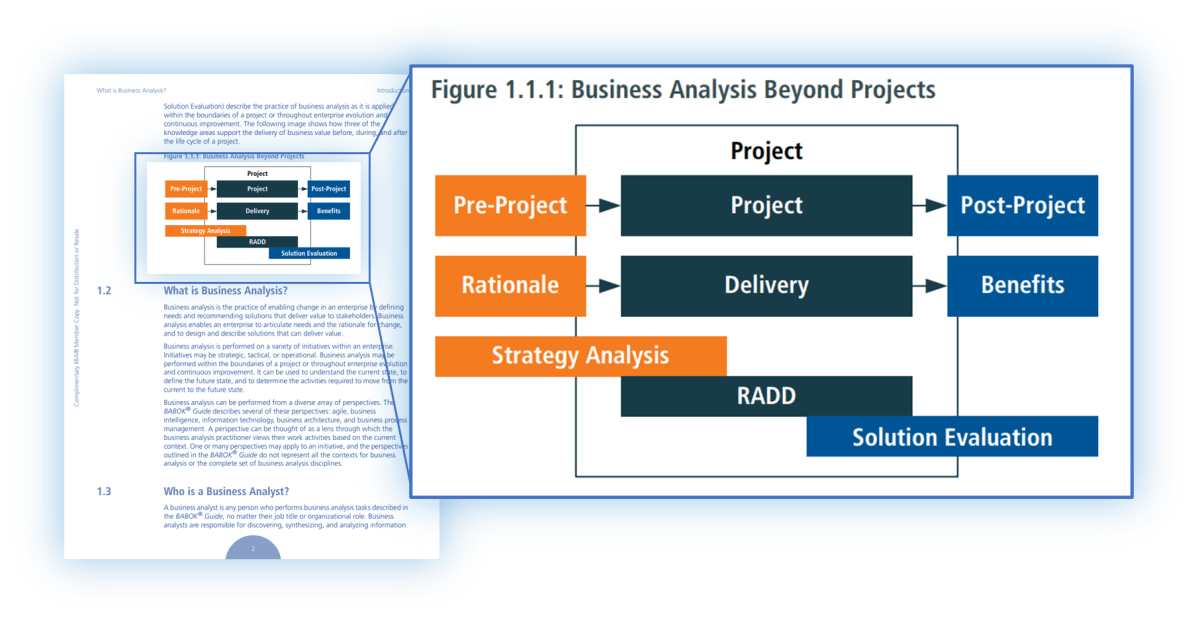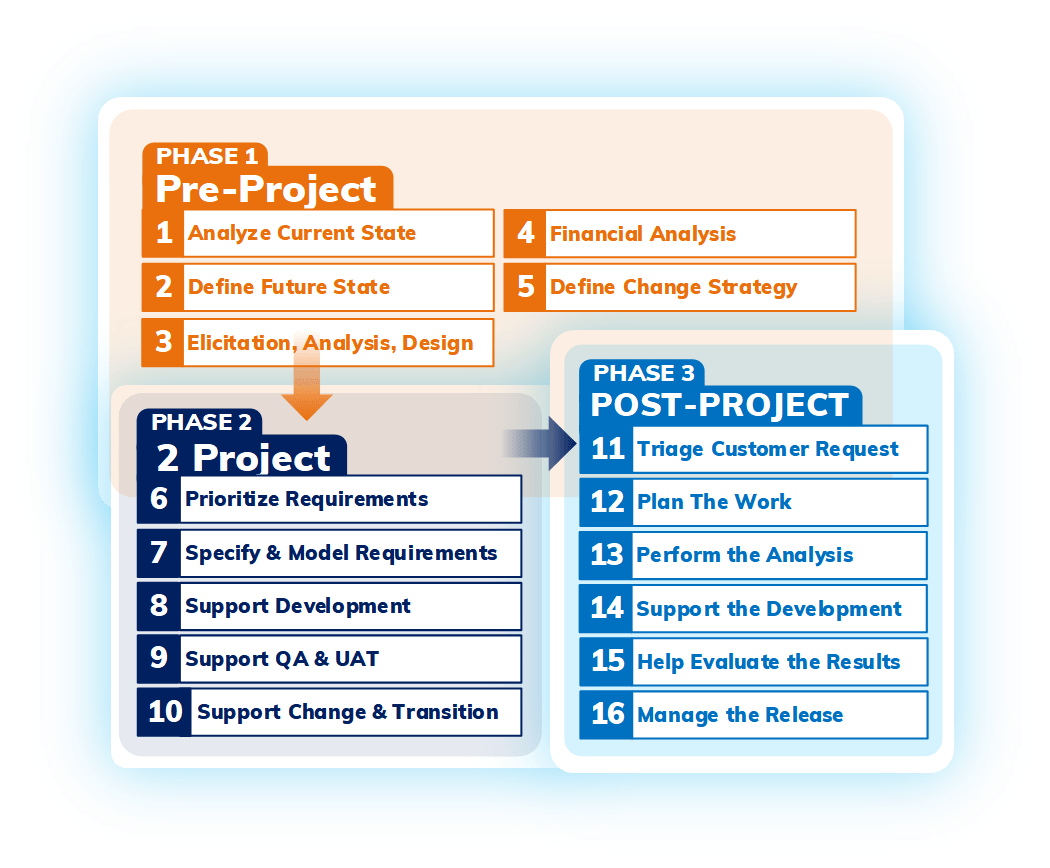Business analysis is an important profession with much bigger responsibilities than just "looking after software". This article explains what those responsibilities are, and what skills you need to embrace the additional responsibilities to grow your BA career.
How Business Analysts Support Digital Transformations
It's true that most business analysts start their careers by looking after enterprise-class software products, but that is only the first step in a business analyst's career progression.
As a business analyst, you have the opportunity to progress in your career by learning to deliver across all three phases of the digital transformation lifecycle.
The 3 Phases of Digital Transformation
Business transformation initiatives have three distinct stages that the business analyst can support with the tools, techniques, guidelines, and outputs defined in the BABOK.
The International Institute of Business Analysis (IIBA) defines these three stages on page 2 of the BABOK version 3 as:
- PHASE 1: Pre-Project
- PHASE 2: Project (aka Project Execution)
- PHASE 3: Post-Project

The role of the business analyst and the project manager is to support the sponsor through each stage of the transformation using the tools and techniques available to them in their respective bodies of knowledge (BABOK for BAs, PMBOK for PMs).
The following table provides a summary of how the PM and BA work together through each stage of a transformation to help fund, deliver, and evolve a solution.
| Roles | 1. Pre-Project | 2. Project | 3. Post-Project |
|---|---|---|---|
| Project Sponsor's Goals | Secure funding for their initiative. | Maintain alignment between solution and business needs. | Evolve solution to continue meeting business needs |
| Project Manager | Estimate project schedule and costs using future state and business requirements | Manage project scope, cost, schedule, and risks until the solution is delivered. | Manage the smaller enhancement projects through product evolution. |
| Business Analyst | Determine high level scope and requirements through pre-project activities | Elaborate requirements into detailed specifications through project execution activities | Resolve defects and roll out enhancements through the product's lifecycle. |
Let's elaborate on the role of the business analyst down to the level of activities & outputs.

PHASE 1: Pre-Project
During the pre-project phase of an initiative, management is tasked with making difficult strategic investment decisions by answering one key strategic question.
Should we invest the time, money, and human resources needed to fix this issue we've identified or take advantage of this opportunity we have in front of us?
Business analysts at the pre-project stage of an initiative help management make these decisions by examining the current state of the situation, determining the future state, and helping to build a business case to help them make a well-informed business decision.
The pre-project work can take days, weeks, or months of time to complete and comes well in advance of any consideration for software development.
Why do this much work before a project?
The pre-project phase and business case are, in essence, a risk management tool for executives. Larger projects often require management to invest millions or tens of millions of dollars over many years of transformation work to achieve their intended outcomes. A multi-year change initiative like this can also be highly disruptive to business operations over an extended period of time.
Risk-minded executives are unwilling to spend millions of dollars and disrupt existing business operations for years without first performing their due diligence.
Conducting pre-project work makes business sense for large-scale transformation initiatives because it helps management understand and manage the many risks involved in digital transformation.
Pre-Project Business Analysis
Smaller business cases can be completed by the sponsor and project manager alone, but once the breadth of the challenge/opportunity expands to a certain size, formal business analysis becomes critical.
Here are the formal BA tools and techniques that can be employed to help management perform their due diligence for their strategic investment decisions.
#1 • Current State Analysis (aka 'Discovery') - This BA task describes the existing state of the processes and systems the organization has in place to support its business operations scope being considered for transformation. The current state description is accompanied by a list of "issues & opportunities" or "pain points" the initiative can address as part of the transformation initiative. [Section 6.1 of the BABOK v3 pg. 103] [Section 7.4 of the BABOK v3 pg. 148]
#2 • Future State Design (aka 'Solutioning') - This BA task helps elicit and describe the vision that management has for the new world they want to create through the transformation initiative. These future state deliverables should contain a comprehensive set of future state process models and a high-level system context diagram that outlines the systems and interfaces that will need to exist to support them. [Section 6.2 of the BABOK v3 pg. 16]
#3 • Business Requirements (BRD) - This BA deliverable provides a comprehensive list of features & functions that stakeholders have expressed along with defining the enabling and limiting parameters such as technical constraints, business constraints, and in-scope areas of exploration, and areas that are explicitly out of scope. [Section 2.3 of the BABOK v3 pg. 103]
#4 • Business Case - This BA deliverable summarizes the cost/benefits of delivering the future state and presents the conclusion to management in a clear and succinct format to help them make the investment decision. The business case often includes a summary of the future state vision & requirements along with a detailed cost buildup and a calculation of the payback period for the investment. [Section 10.7 of the BABOK v3 pg. 234]
#5 • Define Change Strategy - This BA deliverable defines the non-product related elements of a solution including the deployment schedule of the MVP vs. future releases, training strategy, and the stop-gap operations that the business may need to enact as the initiative is delivered in phases. [Section 6.4 of the BABOK v3 pg. 124]

PHASE 2: Project Execution
Project sponsors and project managers often instruct the project team to transition to phase 2 with the assumption that the business case will eventually get approved.
While the business case is being contemplated by the executive management of the organization, the project team is often busy with the transition work that's needed to mobilize the team for project execution.
For the business analyst, this is the chance to build the product backlog and to
The birth of the product backlog.
The business analyst's first task is to build the product backlog. The BA performs this task by "operationalizing" the BRD into the product backlog as backlog items are assembled in accordance with the requirements architecture of the BRD.
This often means transferring the BRD requirements into backlog management software such as Jira or Azure Boards to prepare for the release planning and sprint planning sessions that will guide the development of the product.
Project-Execution Business Analysis
Armed with a working product backlog and an understanding of stakeholder priorities, the business analyst can begin to prioritize the requirements.
#6 • Prioritize Requirements - This BA task gives the dev team clear direction on what to focus on during each sprint and release of the product increment. Prioritization takes into account the customer desires, but must also factor in logical dependencies, technical constraints, and business constraints that exist on the project. That's why having the BRD completed at phase 1 is so useful for this activity.
#7 • Specify & Model Requirements (aka 'Elaboration') - This BA task gives the development & QA team the details they need to build and test the software product. These developer-level details are often an elaboration of the business requirements that were agreed upon during the pre-project phase.
#8 • Support the Development - This BA task removes development obstacles by allowing the development team to get instant clarification on the questions they have. This can include getting clarity on the data model, the business rules, the user interactions, and any other element that the BA may have defined when modeling the requirements.
#9 • Support the QA & UAT - This BA task gives the quality assurance testers and user acceptance testers the support they need to create and execute their test cases. The support work the BA performs here can include holding requirements review sessions, reviewing the test cases developed for correctness, and triaging the defects discovered during QA.
#10 • Support the Change & Transition - This BA task gives the change managers, trainers, and other stakeholders the support they need as they absorb the new product into their business operations. This may involve the BA preparing training materials, conducting training sessions for end users, conducting "train the trainer" sessions for the learning and development group in charge of change management, and providing guidance on the creation of new operating procedures to the business stakeholders.
PHASE 3: Post-Project
The business analyst's job is not finished when the solution is delivered to the customer. In fact, the post-project solution support & enhancement work is often the longest phase of the solution lifecycle, requiring continuous business analysis support.
Weren't requirements done in phase 2?
Phase 3 of an initiative may see many smaller enhancement projects within it as part of the company's efforts to continually evolve the delivered solution as business needs change over time.
For this reason, there are many parallels between phase 2 and phase 3 business analysis skillset. The phase 3 skills can be seen as a subset of the phase 2 BA skillset.
Post-Project Business Analysis
If the BA role you’re aiming for requires you to do heavy project execution work, then you’re most likely to be in a full waterfall or a hybrid agile environment.
#11 • Triage Customer Request - This BA task provides the analyst's input into the inbound customer requests to allow for prioritization. This is very similar to the "prioritize requirements" task performed during project work, with the important difference that items are streaming in one-by-one through multiple sources such as the ITSM processes.
#12 • Plan the Work - This BA task provides the customer with estimates of when their requests can be satisfied by the project team.
#13 • Perform the Analysis - This BA task includes the requirements analysis and functional specification work that analysts need to perform during product enhancements and defect resolution requests.
#14 • Support the Development - This BA task is very similar to the dev support task mentioned in phase 2, with an important difference in scale.
#15 • Help Evaluate the Results - This QA task often becomes the responsibility of the BA in post-project situations. The BA can be expected to take on the testing responsibilities in the absence of fully dedicated QA teams.
#16 • Manage the Release - This QA task also often becomes the responsibility of the BA in post-project situations. DevOps / project management work that sees a solution moved through the development, test, and QA environments to get into production.
Key Takeaways
Employers value versatile business analysts who can tackle any challenge, no matter what stage of the business transformation initiative.
Versatility requires you to build the foundational business analysis skillset as an entry into the profession and to build on that foundation with the additional skills you need to deliver value across all three phases of a business transformation initiative.
We've developed our platform and courses to help you learn the right skills to position yourself as a high-performing versatile business analyst that any employer would love to have on their team.
Ready to become a versatile business analyst? Explore our courses now!

About the Author
Emal Bariali is a seasoned business analysis professional with 20+ projects executed since starting his BA career in 2005.
Emal managed to increase his yearly business analysis income fivefold by enhancing his BA skills and transitioning to BA consulting. He now works in one of the strongest BA job markets in the world: the Greater Toronto Area.


Well Explained Post. thank you for sharing.
You’re welcome.